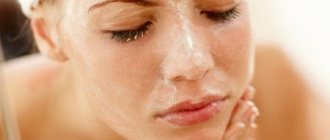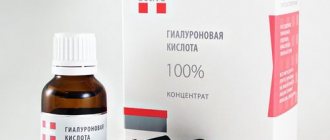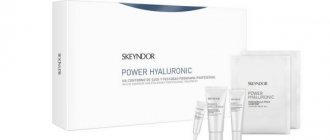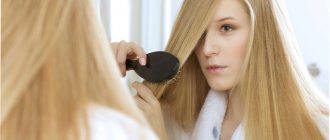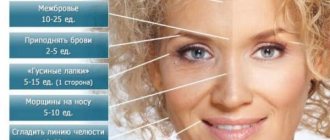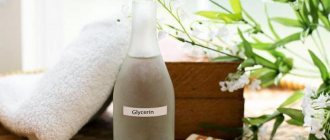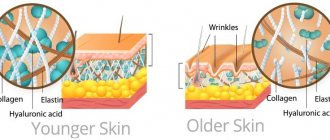What is lauric acid
Lauric (dodecanoic) belongs to the category of carboxylic acids. In its pure form it is a white powder with a subtle and not very pleasant oily odor, which evaporates when heated.
The melting point of the crystals is 440 C, the boiling point is about three hundred degrees Celsius.
It is a “saturated fat,” a medium-chain triglyceride that is more easily absorbed by the body than long-chain triglycerides. The chemical structure is simple. Thanks to this, the body digests and absorbs lauric acid in a similar way to carbohydrates. The empirical formula is C12H24O2, molar mass is 200.31 g/mol.
Side effects of hyaluronic acid
When used carefully, the properties of the substance rarely cause side effects. However, if there are contraindications or incorrect dosages, harm is still possible. It is usually expressed in swelling of the tissues, redness on the skin and the appearance of hematomas on the face - the latter more often occur in smokers.
The listed side effects disappear within a few days, but there are also more serious consequences. For example, if injections are carried out carelessly, fibrosis may occur - thickening of the skin at the injection site. In rare cases, scars or granulomas may form.
To avoid side effects, after beneficial injections you should:
- avoid direct sunlight and do not go to the solarium;
- refuse physical activity;
- do not visit baths, saunas and swimming pools;
- do not take too hot a bath or shower;
- do not use decorative cosmetics and scrubs.
You need to follow these recommendations for about 3 days. After the expiration of the period, the deep and superficial layers of the epidermis will return to normal, and you will be able to enjoy the effect of hyaluronic acid without giving up your usual activities and procedures.
How do you get it?
The raw materials for the production of lauric acid are “tropical” vegetable oils: coconut, palm kernel, kiwi extracts, etc. In general terms, the process looks like this: the raw materials, mixed with reagents, are placed in a porcelain container, which is placed in a water bath.
Under the influence of elevated temperatures and reagents, separation of the mixture begins to occur. The top layer consists of saturated acids, the bottom layer consists of trihydric alcohol glycerin. The top layer is removed and the fraction consisting of acids is divided into separate components.
Under industrial conditions, dodecanoic acid is isolated from vegetable oils by hydrolytic cleavage, saponification, or using the Twitchell method, which involves the use of a catalyst.
Why is it used?
Content:
- Why is it used?
- Useful qualities
- Negative effects and contraindications
- Research on hyaluronic acid by scientists
This question comes up quite often. The acid has good absorbing properties - one molecule can hold 500 molecules of water. Therefore, getting between the cells, it prevents moisture from evaporating. Water remains in the tissues for a long time. The substance is able to preserve the youth and beauty of the skin. However, with age, its production by the body decreases, and the skin begins to fade. In this case, you can use hyaluronic acid injections.
Beneficial properties for the body
- Helps rejuvenate the skin and improve its appearance.
- Helps get rid of blackheads and acne.
- When it enters the body, it “works” as an antioxidant. Lauric acid combats free radicals, which reduces the likelihood of malignant tumors.
- Has a positive effect on brain function. Medicines containing lauric acid improve the condition of patients suffering from Alzheimer's disease.
- Accelerates metabolism, which greatly contributes to weight loss and normalization of glucose levels.
- Mobilizes the body's defenses, which is especially important in case of weakened immunity and during a flu epidemic.
- Fights fungi, viruses and pathogenic microflora.
- Reduces the level of “bad” cholesterol.
- Can provide real help in the fight against intestinal infections caused by the Giardia lamblia parasite.
Contraindications to the use of hyaluronic acid
The benefits and harms of hyaluronic acid when taken orally or through injections depend on the presence of contraindications. To ensure that the beneficial properties of a substance do not cause harm, you need to know when not to use it. Hyaluronic acid is prohibited when:
- diabetes mellitus;
- oncology;
- blood diseases;
- ulcers and gastritis - do not take tablets with this substance;
- dermatological rashes;
- allergies.
Hyaluronic acid is also not recommended for pregnant women; its properties should not be used during lactation, during colds, or during infectious diseases. You cannot carry out beneficial injections immediately after deep peeling, photorejuvenation procedures or laser resurfacing - you need to wait at least a month.
The effectiveness of lauric acid
When it enters the body, lauric acid smoothly transforms into a chemical compound endowed with antimicrobial, antifungal and antiviral properties. This is monolaurin, whose task is to disrupt the structure of lipid membranes that make up pathogenic microorganisms, followed by their destruction.
If food contains insufficient amounts of lauric acid, the body will experience a deficiency of monolaurin. This substance has amazing properties, which can be easily proven. Breastfed children practically do not suffer from infectious diseases. Because they are protected by monolaurin, a derivative of lauric acid, which is part of breast milk.
If you partially replace sunflower oil with coconut oil, then after a while the functioning of the digestive system will noticeably improve.
Indications for the use of hyaluronic acid for the face
It is recommended to start taking the substance not just like that, but if there are appropriate indications. They are:
- noticeable aging of the skin and the appearance of wrinkles;
- signs of disturbance of the water balance of the epidermis;
- joint diseases and inflammatory processes associated, among other things, with impaired fluid metabolism;
- eye diseases.
If the listed ailments or age-related skin changes are not observed, there is no reason to resort to hyaluronate. If there is an excess of a substance in the body, its properties can cause harm rather than benefit.
Contents in products
| Product | Content in % |
| Palm kernel oil | 47 |
| Babassu oil | 43,5 |
| Coconut oil | 42 |
| coconut flakes | 29 |
| Coconut pulp | 15 |
| Coconut milk | 10,5 |
| Chocolate bars | 3-6,5 |
| Butter | 2,8 |
| Cheeses | 0,8-1,3 |
| Margarine | 0,45 |
| Palm oil | 0,4 |
| Ice cream | 0,3 |
Scope of application
Pharmaceuticals
Lauric acid tends to enhance the effect of antibiotics, so it is included in drugs intended to treat intestinal diseases. It will also be useful to remember monolaurin, which helps eliminate intestinal infections.
When interacting with bacterial antigens, lauric acid can have a powerful immunostimulating effect. This substance is often included in medications intended to alleviate the condition of patients with cancer, diabetes and AIDS.
Some pharmacological companies produce monolaurin in its pure form, which functions as a dietary supplement. It can be used as an antidepressant.
Cooking
Nutritionists recommend using coconut oil for cooking, which contains large amounts of lauric acid. Thanks to coconut oil, you can reduce cooking time and enrich your diet with beneficial substances, including antioxidants and monolaurin.
Instructions for use of hyaluronic acid
Hyaluronic acid is sold in several forms - tablets, ampoules and powders. Methods of application and dosage vary, so you need to know in what quantities and under what conditions the drugs can be used.
In tablets
For joint diseases and to improve skin condition, hyaluronic acid in capsules and tablets is beneficial. Take 1 tablet three times a day with food, washing down with water; there is no need to chew the drug. The nutritional supplement is taken in a course - the intake should last at least a month.
Important! When using hyaluronic acid tablets, it is extremely important to drink at least 2 liters of water per day.
This condition cannot be neglected; the benefits and harms of hyaluronic acid in tablets depend on it, because the properties of the substance lie precisely in the binding of water molecules in tissue cells.
In ampoules
Injections of beneficial hyaluronic acid are carried out for both medical and cosmetic purposes, and in the latter case, the dosage should be no more than 30 mg for a separate area of the skin. Since the substance in injections has a quick and strong effect, injections must be carried out under the supervision of a cosmetologist. Self-administration of the substance for injections under the skin of the face is categorically not recommended - if the procedure is carried out incorrectly, it will only cause harm.
If hyaluronic acid preparations are used to treat joints, then you must follow the instructions for the specific product or doctor’s prescriptions. If self-medicated, injections may be useless or even harmful.
Powder
In addition to tablets and ampoules, you can find hyaluronic powder in pharmacies. It is usually used to prepare a solution for facial skin - dilute a pinch of powder in 30 ml of water and leave for half an hour to an hour until the product swells. After this, the mixture is mixed to eliminate lumps and distributed over clean skin, and a mask or cream is applied on top.
Contraindications and possible harm
With dosed and reasonable consumption of dietary supplements and products containing lauric acid, it cannot cause harm to health. The only contraindication is individual intolerance.
If you eat more coconut oil than normal, you should reduce the amount of carbohydrates in your diet. As for pregnant women and nursing mothers, they are not recommended to overuse coconut and other oils rich in lauric acid. Since its effect on the body is not fully understood.
Reviews from doctors
Ilyin Vladislav Sergeevich, 42 years old, Moscow
I work as a rheumatologist and regularly prescribe hyaluronic acid in the form of injections to my patients as an adjuvant therapy in the treatment of joints. I would like to note that the remedy begins to act immediately, pain and inflammation are noticeably reduced. Among the advantages of hyaluronate is the rare occurrence of side effects and bruises.
Andreeva Irina Vasilievna, 35 years old, Ekaterinburg
I often prescribe hyaluronate to my patients as an alternative to collagen - the substance is much safer and works much better. The acid has a powerful rejuvenating effect on the skin of the face and neck, especially for women over 35 years old. The main thing is not to use the product too often, otherwise the natural processes of the body will be disrupted.
Medicines and dietary supplements containing lauric acid
"Monolaurin"
An antibacterial, antiviral, antiparasitic drug, which is not a medicine, but a dietary supplement. Produced under the Solaray brand, packaged in a plastic container. Number of capsules – 60.
The active component is an extract from coconut oil, enriched with silicon dioxide and magnesium stearate. Can be taken to strengthen and restore immunity (after illness or surgery). In fact, the scope of application is quite wide:
- fungal skin diseases;
- HIV;
- flu;
- chlamydia;
- viral diseases;
- lichen;
- stomatitis;
- staphylococcus;
- high cholesterol;
- papillomas.
"Lauricidin"
An analogue of Monolaurin, produced under a different brand and name – Lauricidin. The American manufacturer offers consumers a whole line of its products, which includes not only dietary supplement capsules, but also cosmetic and hygiene products containing the purest monolaurin. This is toothpaste, deodorant, hand cream, face cream, lotion.
Also, the line includes cosmetics with “improved formulas” that are most effective.
"Hair Expert", strengthening lotion from "Evalar"
The purpose of the drug is to increase hair volume and strengthen it to prevent hair loss. The lotion is made on an alcohol basis. It contains the Liposentol-N complex, as well as several highly effective components, including: L-carnitine, lauric acid and aminophylline.
The firming lotion is easy to use. It is applied to the scalp and rubbed into it with light movements. After this, you can perform various manipulations with your hair. For example, styling using a hairdryer and styling products. To enhance the effect or if it is not possible to use lotion, you can take the tablets of the same name - “Hair Expert”. They are also produced.
Harm of hyaluronic acid
A useful substance, if used carelessly, can cause harm:
- If you use the substance for too long, then its natural production in the body will noticeably decrease, therefore, the effect of the properties of hyaluronic acid will have to be constantly maintained artificially.
- If there is insufficient fluid intake into the body, dehydration may occur.
- If the skin is poorly moisturized after masks with hyaluronic acid and injections, increased dryness may be observed.
Advice! Taking the substance must be combined with plenty of drinking - at least 2 liters per day, otherwise the properties will be harmful.

